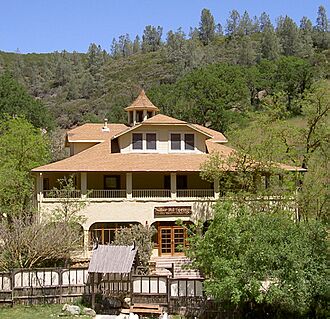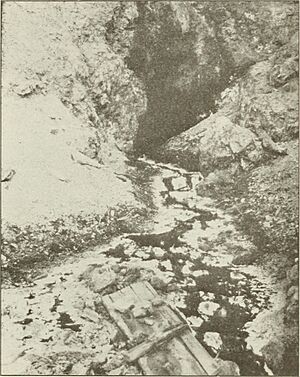Wilbur Hot Springs facts for kids
Quick facts for kids Wilbur Hot Springs |
|
|---|---|
| Simmons Hot Springs Wilbur Hot Sulphur Springs |
|

The lodge at Wilbur Hot Springs
|
|
| Location | near the town of Williams, California, Colusa County |
| Coordinates | 39°2′19″N 122°25′15″W / 39.03861°N 122.42083°W |
| Elevation | 1,350 feet (410 m) |
| Type | geothermal |
| Temperature | 152 °F (67 °C) |
Wilbur Hot Springs is a special place in northern California with natural hot springs. It's about 22 miles west of Williams in Colusa County. People also used to call it Simmons Hot Springs. This historic spot has been a spa since the 1800s. In the 1970s, a therapist named Richard Louis Miller bought it. Now, it's a spa resort and a quiet place for people to relax. The land next to it is a protected nature reserve.
Contents
What Makes Wilbur Hot Springs Special?
The hot springs at Wilbur come out of the ground near Sulphur Creek and Bear Creek. The water flows out at about 30 gallons every minute. It's super hot, usually between 140 and 152 °F (67 °C). The springs are located high up, at about 1,350 feet (410 m) above sea level.
Minerals and Mining History
The area around Wilbur Hot Springs has many minerals. People have found gold, silver, mercury, and other elements here. Long ago, there was a lot of mercury (also called quicksilver) mining nearby, especially at the Elgin Mine. These minerals are here because of volcanic activity deep underground. Other mines in the Sulphur Creek area also looked for gold, copper, and sulfur.
The water from the springs has a lot of sulfur in it. In 1911, a report from the United States Geological Survey described different springs:
- Spring No. 1 was a hot sulfur spring.
- Spring No. 10 (also called Black Sulphur Spring) was west of the main hotel.
- Spring No. 22 (the Main Springs) was also west of the hotel. Its water was a clear yellow color because of the minerals.
- The Chromatic Spring was special because its water changed colors, from reddish-purple to bright green or black! This was due to tiny algae and minerals.
- Spring No. 20 (the Catarrh and Complexion Spring) had very salty, sulfur-rich water.
- There were also cold springs, like Spring No. 24 (Cold Magnesia Spring) and Spring No. 30 (Cold Black Sulphur Spring).
By 1976, there were 12 active springs flowing at Wilbur Hot Springs. The water contains many minerals like sodium, potassium, calcium, magnesium, and sulfur. It also has gases like carbon dioxide.
Water Details
Here are some facts about the hot spring water:
- Temperature: 152 °F (67 °C)
- Flow: 30 gallons per minute (114 liters per minute)
The Resort at Wilbur Hot Springs
Wilbur Hot Springs is a spa resort that covers 1,700 acres (690 ha) of land. This includes a large 1,560-acre (630 ha) nature reserve. There's even a geyser on the property that erupts every hour!
Guests can stay in the main lodge, which is a 3-story hotel built in 1915. There are also cabins and camping spots. The super hot spring water is cooled down for people to bathe in. The resort also has cool springs, saunas, yoga classes, and massages. There are two dining rooms and a library for guests.
Getting to the resort is an adventure! You have to drive on a dirt road. The resort is "off-grid," meaning it makes its own power using solar panels. As of 2018, Wilbur Hot Springs is the only business left in the old Sulphur Creek Mining District.
History of Wilbur Hot Springs
The history of Wilbur Hot Springs goes back hundreds of years. Before European settlers arrived, Native American tribes like the Patwin, Pomo, Wintun, and Colusi used these springs. They believed the waters had healing powers.
Early Discoveries and Development
Local stories say that in 1863, a wealthy activist named General John Bidwell was looking for gold. One of his men became very sick. Native Americans told Bidwell about the powerful waters at the springs. Bidwell brought his sick man there, and he got better! General John Bidwell then told everyone in San Francisco and Chico about these amazing healing waters.
In the late 1800s, hot springs became very popular in America. Rich people loved to visit fancy hot spring resorts. Getting to Wilbur Hot Springs was a long and hard journey, but it became as famous as the spas in Baden-Baden, Germany.
However, European settlers were also interested in the minerals in the ground, not just the water. They first looked for copper and sulfur, then gold. In 1863, Ezekial Wilbur and Edwin Howell bought a 640-acre (2.6 km2) ranch for $1,500. They planned to mine copper, but it didn't work out. Within eight months, Wilbur bought Howell's share for $200. He then built a wooden hotel and opened 'Wilbur Hot Sulphur Springs' in 1865.
Growth and Changes
Later that year, Wilbur Hot Sulphur Springs was sold to Marcus Marcuse. The stories of "miraculous cures" at Sulphur Creek continued to spread. By the 1880s, the resort was very popular. It was known for its super hot water that bubbled up over a large area. To get there, guests would take the Southern Pacific Railroad to Williams. Then, they would travel 22 miles (35 km) by stagecoach, which took about four hours!
By 1891, Wilbur's resort was not doing as well. A mile down the road, Sulphur Creek Village had a newer resort and a gold mining village. Wilbur's place had old bathhouses and cabins, and "no hotel worthy of the name." In 1909, it became a U.S. Post Office (until 1945) and a stop for the stagecoach.
In 1915, the old cabins were torn down. The owner, J. W. Cuthbert, built the concrete hotel that stands today. It was one of the first buildings in California made from poured concrete. Over the years, the property changed owners many times.
Climate Around Wilbur Hot Springs
The climate around Wilbur Hot Springs is called a "Mediterranean Climate" (Csa). This means it has hot, dry summers and mild, wet winters.
| Climate data for Williams | |||||||||||||
|---|---|---|---|---|---|---|---|---|---|---|---|---|---|
| Month | Jan | Feb | Mar | Apr | May | Jun | Jul | Aug | Sep | Oct | Nov | Dec | Year |
| Mean daily maximum °C (°F) | 12 (54) |
16 (61) |
19 (66) |
23 (73) |
28 (82) |
33 (91) |
36 (97) |
35 (95) |
32 (89) |
26 (79) |
18 (65) |
13 (55) |
24 (76) |
| Mean daily minimum °C (°F) | −1 (31) |
4 (39) |
5 (41) |
7 (45) |
11 (52) |
14 (58) |
16 (60) |
14 (58) |
13 (55) |
9 (48) |
5 (41) |
2 (36) |
8 (47) |
| Average precipitation mm (inches) | 79 (3.1) |
66 (2.6) |
51 (2) |
23 (0.9) |
10 (0.4) |
5.1 (0.2) |
0 (0) |
2.5 (0.1) |
10 (0.4) |
20 (0.8) |
53 (2.1) |
71 (2.8) |
390 (15.3) |
| Average precipitation days | 8 | 7 | 7 | 4 | 2 | 1 | 0 | 0 | 1 | 3 | 6 | 8 | 47 |
| Source: Weatherbase | |||||||||||||


